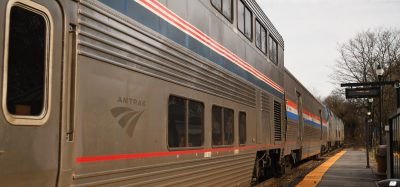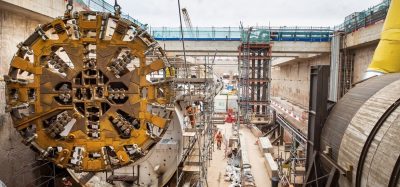Brenner Base Tunnel construction continues as expected
Posted: 19 September 2012 | | No comments yet
Construction of the 64km-long Brenner Base Tunnel is in full swing. Two sections of the exploratory tunnel are completed, the access tunnel in Mules now connects the exploratory tunnel with the surface, and two more logistic tunnels are ready for use.
The Brenner Base Tunnel (BBT) is a straight, flat railway tunnel connecting Austria and Italy. It runs from Innsbruck to Fortezza (55km) and connects to the existing Innsbruck bypass, where a further parallel rescue tunnel is being built as part of this project. If you add the Innsbruck railway bypass, which has already been built and which is the endpoint for the Brenner Base Tunnel, the length of the entire tunnel through the Alps is 64km. Once finished, it will be the longest underground railway infrastructure in the world.
The BBT constitutes the centrepiece of the high-capacity railway line between Munich and Verona. At the same time, it represents the key element of the European Corridor No. 1 Berlin–Palermo which runs for 2,200km from North to South, also known as the TEN-1 axis. The European Union supports the expansion of this transnational stretch and considers it a top priority.
Construction of the 64km-long Brenner Base Tunnel is in full swing. Two sections of the exploratory tunnel are completed, the access tunnel in Mules now connects the exploratory tunnel with the surface, and two more logistic tunnels are ready for use. The Brenner Base Tunnel (BBT) is a straight, flat railway tunnel connecting Austria and Italy. It runs from Innsbruck to Fortezza (55km) and connects to the existing Innsbruck bypass, where a further parallel rescue tunnel is being built as part of this project. If you add the Innsbruck railway bypass, which has already been built and which is the endpoint for the Brenner Base Tunnel, the length of the entire tunnel through the Alps is 64km. Once finished, it will be the longest underground railway infrastructure in the world. The BBT constitutes the centrepiece of the high-capacity railway line between Munich and Verona. At the same time, it represents the key element of the European Corridor No. 1 Berlin–Palermo which runs for 2,200km from North to South, also known as the TEN-1 axis. The European Union supports the expansion of this transnational stretch and considers it a top priority.
Construction of the 64km-long Brenner Base Tunnel is in full swing. Two sections of the exploratory tunnel are completed, the access tunnel in Mules now connects the exploratory tunnel with the surface, and two more logistic tunnels are ready for use.
The Brenner Base Tunnel (BBT) is a straight, flat railway tunnel connecting Austria and Italy. It runs from Innsbruck to Fortezza (55km) and connects to the existing Innsbruck bypass, where a further parallel rescue tunnel is being built as part of this project. If you add the Innsbruck railway bypass, which has already been built and which is the endpoint for the Brenner Base Tunnel, the length of the entire tunnel through the Alps is 64km. Once finished, it will be the longest underground railway infrastructure in the world.
The BBT constitutes the centrepiece of the high-capacity railway line between Munich and Verona. At the same time, it represents the key element of the European Corridor No. 1 Berlin–Palermo which runs for 2,200km from North to South, also known as the TEN-1 axis. The European Union supports the expansion of this transnational stretch and considers it a top priority.
The company in charge of constructing the tunnel-system is the BBT SE. It was founded in 2004 as Europe’s first Societas Europeae. The shares of the company are equally divided between Austria and Italy (50:50). The share – holders are the Austrian Railway Company, ÖBB (holds 50%); the Italian Railway Company, RFI (holds 42%); and the remaining 8% belong to the Provinces of Bolzano, Trento and Verona.
The project
The BBT consists of two rail tunnels, each equipped with a single track. The distance between the tunnels is 70m for nearly their whole extension. Near the portals, this distance decreases to approximately 4m. These two main tubes have an internal diameter of 8.1m and they are connected at regular 333m intervals by cross tunnels which will serve as escape routes in emergency situations.
An exploratory tunnel will be located 12m below the two main tunnels. This exploratory tunnel, with an inner diameter of approximately 5m, is to be driven prior to the construction of the main tubes as it provides information on the geological and hydrogeological composition of the rock. This preliminary research will help to minimise both construction costs and risks. Eventually the exploratory tunnel will run the length of the main tunnels and will be used during operation as a drainage tunnel and, where necessary, as a service tunnel.
The longitudinal gradient of the BBT is 6.7‰ on the northern side and 4‰ on the southern side of the Brenner. The apex height lies at 790m above sea level, which means that the tunnel runs more than 580m beneath the Brenner Pass (1,370m above sea level).
In total, the BBT system will include approximately 200km of tunnels: the two main tubes, the exploratory tunnel running from one end to the other and all the lateral access tunnels and cross-passages. Approximately one third will be excavated conventionally, with the rest by mechanised systems.
Construction progress
Work is currently underway on five construction sites along the Brenner Base Tunnel. So far, 24km of exploratory and access tunnels have been excavated. An overview of the con – struction activities from North (Austria) to South (Italy) is as follows:
In Austria
Excavation is currently underway on the Innsbruck–Ahrental stretch of the exploratory tunnel and three access tunnels.
Construction on the Ampass lateral access tunnel has been underway since May 2012. In the first 300m of alternately loose and solid rock, the excavation had to be carried out respectively with diggers and by drilling and blasting. At a depth of 300m, the tunnel reached the Innsbruck Quartzphyllite, which can be excavated by conventional drilling and blasting. Due to the reduced cross section, two overtaking niches and two niches for turning manoeuvres will be excavated. At the end of the lateral access tunnel, the rescue tunnel towards Tulfes and Bergisel will be built parallel to the Innsbruck bypass. Furthermore, a conveyor belt will be installed along the regional road L283 to transport the spoil from the portal to the Ampass Süd disposal site.
The 2.4km-long Ahrental access tunnel is being excavated cyclically, starting with the crown or calotte and then moving to the bench and the slab. Approximately 2.2km have already been built. The excavation works are expected to be terminated in October 2012.
Since December 2009, work has been underway on the Innsbruck–Ahrental exploratory tunnel in the Sill gorge near the city of Innsbruck. The excavation works of the exploratory tunnel from Innsbruck to the Brenner Pass were concluded when the intersection with the access tunnel Ahrental was reached. Now, the tunnel floor drainage of the 4,360m-long tunnel will be built. The excavation works for the exploratory tunnel moving from a northern to southern direction will be continued as soon as the access tunnel Ahrental is interconnected with it.
In Wolf, near Steinach am Brenner, multiple parallel excavations were carried out by blasting in the Wolf lateral access tunnel, the Padaster tunnel and the Saxen tunnel. The Padaster tunnel and the Saxen tunnel are both meant to serve construction site traffic. Spoil is transported through the approximately 700mlong Padaster tunnel to the Padaster disposal site located near the portal. The Saxen tunnel is a direct connection between the construction site and the Brenner highway A13. Thus, the building site traffic keeps away from public roads and disturbance for the neighbours and the environment is kept to a minimum. The excavation works for both tunnels and for the first 200m of the Wolf access tunnel have been completed.
In Italy
The first construction lot of the Mules access tunnel and the first part of the exploratory tunnel in Aica (10.5km) have been completed. Construction continues northwards towards the Brenner Pass by blasting. This stretch crosses the Periadriatic seam, a fault line, where the excavation work requires the greatest of care. At the same time, several preparatory works are carried out, meaning the caverns for the assembly of the tunnel boring machine used in future tenders and the connection between the exploratory tunnel and the future main tubes. The latter structure will be of particular importance in terms of logistics, because in the future the spoil will be transported to the disposal sites through the exploratory tunnel using conveyor belts.
Costs and financing
The estimated costs for the Brenner Base Tunnel (at 1 January 2012) amount to €8,585 billion, including risks that are not fully quantifiable yet. Every year, the costs and risks are re-evaluated and carefully surveyed. The major cost groups can be identified as follows:
- Civil work: 60%
- Rail and technical equipment: 15%
- Management costs and ground rents: 12%
- Risk contingencies: 13%
The financing of the Brenner Base Tunnel can be guaranteed by assigning approximately a third of the costs respectively to Austria, Italy and the EU.
Operation and traffic
The BBT is meant primarily for freight transport, allowing a modal shift of traffic from road to rail. Passenger trains can also travel through the tunnel. Thanks to the virtually horizontal tunnel, train traffic will no longer have to contend with the steep up and downhill slopes on the Brenner railway line that is now over 140 years old.
At 1,370m, the Brenner Pass is the lowest crossing point in the Central Alps and is passable all year round. Since man discovered the Alps as a habitat, it has always been used as a crossway. Nowadays, freight transport on the mountain stretch is difficult and complicated. Fifty million tonnes of freight transport was recorded over the Brenner in 2011 – the Brenner highway and the railway line are nearing their capacity limits. Only one third of freight transports are done by rail, but traffic simulations show that freight traffic will increase over time. Therefore, the call for a transnational solution for the traffic problem has been growing for decades.
The vision of a base tunnel surfaced repeatedly over the past century. The building of a new traffic route in the form of a new railway line over the Brenner has been the object of intensive studies and planning for decades. On a new Brenner railway line, heavy freight traffic between Munich and Verona should, in the future, travel underground as much as possible. The existing traffic infrastructures which run mostly aboveground should be used primarily for passenger traffic.
The basic premise of the 1987-1989 feasibility study for the Brenner Base Tunnel was mixed transport as operative system with a capacity of 400 trains per day at the Brenner Pass, 80% of which are freight trains. Just like the other transalpine tunnels in Switzerland, the Lötschberg and Gotthard tunnels, the Brenner Base Tunnel is designed for mixed traffic.
The maximal speed of the stretch for freight trains was set at 160km/h and at 250km/h for passenger trains.
About the author
Konrad Bergmeister has been CEO of BBT SE since August 2006. He was previously the Technical Director of the Brenner Highway. For the past 15 years, Konrad has taught construction engineering at the University of Natural Resources and Applied Life Sciences in Vienna, and has been the President of the Free University in Bolzano since 2010.






